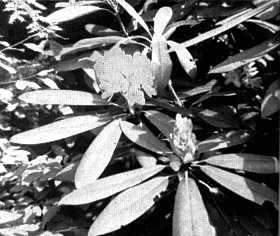QBARS - v13n1 New Hampshire State Park
New Hampshire State Park
By Robert E. Stuart, Littleton, Mass.
Few people realize that Rhododendron maximum known by the common name of Rose Bay grows naturally as far north as southern New Hampshire. The species is very common hundreds of miles to the south in the Appalachian mountain area but is somewhat of a botanical mystery to be found in a few isolated locations so far north.

|
|
Fig. 6.
R. maximum
Stuart photo |
The largest of natural stands in this latitude has been preserved for all time by the state of New Hampshire as a State Reservation. It consists of sixteen acres with many plants fifteen feet and more in height and stems two inches in diameter. The area occupied by the Rhododendrons consists of a typical New England swamp with the usual shrubs and trees interspersed such as swamp red maple, (Acer Rubrum), various Viburnums, high bush blueberries etc. although the Rhododendrons are easily in the majority. A close examination shows the plants grow on hummocks or mounds of peat and fibrous roots, and therefore are above the water table with the lower roots extending into the soil or muck which remains permanently moist. The rhododendrons extend only slightly onto the surrounding hillsides which consist of mineral soils with the usual forest litter. This area is covered mostly with white pine and other associated forest growth with a thick undergrowth of Mountain Laurel (Kalmia latifolia).
The park is located in the southern part of the state about three miles from the rural village of Fitzwilliam in one of the most scenic areas of the state, known as the Manadnock region taking its name from Mt. Manadnock, the highest mountain in that section of the state. The climate is cold with temperatures of -30 F. frequent and with late spring frosts and a very early fall. It would seem as though any hybridizer interested in using Rhododendron maximum as a parent to gain hardiness might find a considerably greater degree of hardiness in offspring from the species which developed under such rigorous climatic conditions.
The area was first acquired by Mary Lee Ware to prevent its destruction from lumbering operations, later given to the Appalachian Mountain Club which maintains extensive hiking trails from Central Maine to Georgia. In 1946 the 278 acre tract was taken over by the State of New Hampshire which has laid out extensive trails around the rhododendron area and on the surrounding hills as well as a beautiful picnic area with fire places. The park is open to the general public from spring to fall being only a short distance from Route 119. Thousands of people visit the park especially in early July when the rhododendrons seldom fail to produce a beautiful array of white and pale pink blossoms. (Fig. 6)
